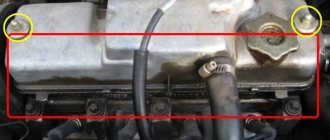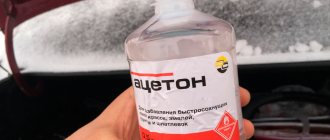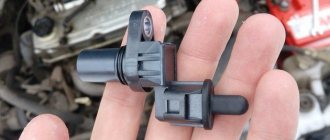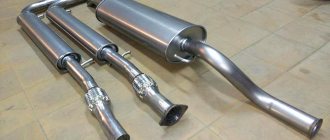Hello again, my readers, sooner or later a situation arises when you need to add transmission oil to the box, but you know what kind of oil is in there, or you know, but there is nothing similar here and now. Is it possible to mix transmission oils with each other, and what are the consequences of this later? On the one hand, the oils are of the same type, which means it’s possible, on the other hand, the composition may be different, which means it’s impossible. What if you can’t, but there’s no other way out? Now let's figure it out in order.
Peculiarities
Let me start with the fact that today there is no single standard or recipe for gear oil. There is also no universal substance suitable for all cars. Even despite the base component (mineral water or synthetic), the additives and proportions in the composition are different. Moreover, this is true not only for different brands, but also for oils from the same manufacturer.
For example, the same company produces a product line that includes synthetics, semi-synthetics and purely mineral products that have similar characteristics, but for different boxes, different machines and different qualities. This means that oils with identical characteristics will have different chemical compositions.
There is a certain API standard, according to which all substances of this standard from different manufacturers must be compatible with each other. Regardless of the brand. But, in practice, even these lubricants are very different from each other, and manufacturers enhance the properties that their cars and gearboxes need, that is, they also have their own specificity.
Therefore, oils that are often similar in API may differ from one another and may not meet the requirements set by the manufacturers of a particular car. And non-compliance with the requirements (of the same viscosity) means a reduction in transmission life.
Tags: сastrol manual taf-x 75w90, castrol syntrans transaxle 75w-90, gear oil
Comments 29
I work at a dealership. Regarding oils: the plant producing the cars itself recommends certain oil manufacturers (). So when the oil manufacturer had the same “replacement” brand, so to speak, there were no complaints. And we filled in the same oils and liquids but under different names... So it’s all the same thing... Although they say that the quality has become even better)))))
Are these oils different for hypoid and non-hypoid gears?
For passenger cars, only oils of groups GL-4 and GL-5 are used. Oils of the GL-4 group are intended for conventional “manual” gearboxes and gearboxes with spiral-bevel or hypoid main pairs under moderate operating conditions. Oils of the GL-5 group are suitable for both moderate and severe operating conditions in gearboxes with hypoid and other types of gears. They can also be used in conventional gearboxes.
Gl-4: Highly additive gear oils with MIL-L-2105 performance level. These oils are used preferably in manual transmissions and steering gears, final drives and low displacement hypoid gears in automobiles and off-road vehicles for the carriage of goods and passengers and for non-transport applications. Hypoid gears operating at high speeds with low torques and low speeds with high torques. Highly effective extreme pressure additives are required
GL-5: Hypoid gear oils with performance level MIL-L-2105 C/D. These oils are preferably used in hypoid bevel gears and circular bevel gears for final drives in automobiles and in motorcycle driveshafts and motorcycle step transmissions. Especially for hypoid gears with high axle displacement. For the most severe operating conditions with shock and alternating loads. Hypoid gears operating at high speeds with low torques and shock loads on gear teeth. Must have a large amount of sulfur-phosphorus containing extreme pressure additive
When mixing occurs
Mixing oils occurs for various reasons, circumstances and conditions. Of course, it is better to use the oils that are written in the car manual; this is the most correct option both when adding and replacing:
- For example, any replacement of oils in a unit, without disassembling and washing it, leads to mixing. Inside, some part of the lubricant still remains on the walls, in the grooves, inside the channels, which will mix with the newly filled one, and this is inevitable. It is important here that as little old substance remains as possible, that is, pour it out while it is hot. Place the machine so that there is no tilt, and after opening the drain plug, all the substance flows through it. You wait longer until the thin stream from the plug hole stops; this is often neglected.
- By mistake of the owner, or the service station workers, when they simply got something wrong. Another common case would be fake oil. It also happens when they forget to pour oil, drain it, tighten the cap, and good-bye. And the next day the client returns with noise to the checkpoint, and then it’s the end of everything. But this is a manual one; an automatic one simply won’t work, because the force is transmitted through the oil.
- The factor is when you need to add lubricant, but you don’t have exactly the same one on hand, there is something similar or completely different from what you need. And driving without lubrication is not an option; this is a death sentence for any gearbox. Even XADO technology, when you can ride without lubrication, is designed for combat conditions, (short term) after which the treated parts will not be suitable for use.
- It is also possible that “crazy people” conduct various experiments on their own cars, as well as on the cars of friends and neighbors, including mixing different oils, which for the first half an hour give amazing effects on the power of the units, and then a major overhaul. They came up with a myth: by mixing mineral water with synthetics 50/50, you will get excellent semi-synthetics, the main thing is that the oils are branded. In fact, we get a substance that is death to the units, the properties of which are far from the required ones, so the wear of parts is maximum, and the benefit is minimal.
Is it possible to do this?
If you take liquids for your car that have the same classification according to API, without additional approvals and manufacturer’s notes, on the same basis, then there will be no harm from mixing. Since their compatibility and interchangeability is guaranteed by this standard. For example, when mixing two gl5 oils, you get a substance that has the same properties, and therefore is suitable for the same operating conditions and units.
It is permissible to mix lubricants of different brands, if the properties are not lost or changed; this applies to oils produced by one factory, only with different stickers. Then they are chemically equivalent, they can be mixed and one substance can be replaced with another. However, sellers of ordinary stores (not company-owned or branded), as a rule, do not have such information. Therefore, when purchasing goods in these stores, you are playing a kind of lottery. I wouldn't recommend this.
You cannot mix automatic transmission oil with mechanical lubricant, compositions of completely different viscosities, the mixture will be equally destructive for both boxes.
What happens if the products are different?
We mixed two products at random, then there are two scenarios.
When different oils are mixed, their components inevitably interact, and as a result, the properties can either improve or deteriorate greatly:
- If you are lucky, then you received a lubricant that meets the requirements of your transmission, and it will serve its life without any incidents.
- If you are unlucky, and the probability of such a scenario is several times higher, then the life of the vehicle’s transmission will be significantly reduced (by half or more). Other side effects are also possible, such as thickening (coagulation), liquefaction, with the formation of various sediments that clog the oil channels. The appearance of corrosion on all parts as a result of a chemical reaction. When mixing different bases, foaming of the substance occurs, which worsens the already weak properties.
Possible consequences of mixing
Many motorists, when faced with the need to replenish the volume of lubricant in a manual transmission (manual gearbox), reason trivially - the transmission does not experience severe loads like an engine, therefore, there are no special requirements for replenishing the volume of motor oil.
An inexperienced driver believes that there is no need to worry about the likely consequences of mixing different petroleum products. Often this approach seems to be the most practical, because manufacturers of consumables set different prices for their own products.
The desire to save money can lead to dire consequences. The car may need major repairs. This is due to chemical reactions that will definitely begin if you mix mineral motor oil with synthetic oil. A special precipitate will appear in the form of white flakes. The gearbox will become clogged, including the oil filter. Its parts will be subject to deformation and severe wear.
Automotive service employees claim that most often the transmission broke down due to pouring mixed lubricant into it (mineral oil plus synthetics). When drivers mix car oils, they hope to get a semi-synthetic product. Of course, this is impossible.
At first, the deterioration of the gearbox may not be particularly noticeable. However, gradually you will begin to notice that modes are not switched as smoothly as before, and wear on parts has increased significantly. These are the negative consequences of operating a car with mixed oil fluid poured into the gearbox.
In case of emergency
When you need to top up and there are no other options, top up with what you have. In a manual transmission it is better to have at least something lubricating than a completely dry one. Therefore, you fill (top up) what you have, just to get to the place where you can completely rinse the box and replace the lubricant. And washing and replacing are mandatory.
But for an automatic transmission, it’s not what’s needed, it’s death, and a quick replacement, because repairs, after driving for God knows what, will cost even more, if it’s possible at all. Call a tow truck, driving without lubrication or with bad fluid is too expensive.
To summarize, I will say that mixing or replacement is justified only in a critical situation, otherwise there is a high risk of transmission failure.
I don't recommend experimenting. Use oils not prescribed by the manufacturer either. Mixing gearbox and engine oil is only permissible in a mechanic's box in order to get to the nearest service station. After which replacement with washing of the unit.
That's all, subscribe to updates, share the link with your friends, let them subscribe too, useful knowledge is never superfluous, and no one is immune from an emergency situation. I wish you all good luck and goodbye.
Important points
To ensure uninterrupted operation of the hydraulics, the lubricant must meet certain requirements:
The Russian Federation has a GOST that meets international standards. For hydraulic fluids, it is marked with the number 17479.3-85, which corresponds to ISO 3448 and consists of three groups of signs: name, viscosity class, field of operation. Since the hydraulic mechanism operates at fairly high temperatures, the oil used must have a flash point even higher so as not to boil. But the freezing temperature should be low. The substance produced is subjected to careful filtration. However, polymer additives added to increase the viscosity index tend to accumulate on the hydraulic system filter element. The pressure sensor signals this in an emergency
When pouring new oil into the system, you need to check the existing filter in it and replace it if necessary. To avoid all kinds of leaks in the hydraulic system, you need to pay attention to the seals. The material from which they are made must be compatible with the lubricant used
Preference is given to proprietary seals designed for specific hydraulics. Do not mix oils intended for different hydraulic systems.











